A place where water is more valuable than diamonds
To the Tswana people, the Okavango Delta is many things: a nurturer, a healer, a confidant. When drenching rains soak the Angolan highlands each September, it takes six months for the life-giving waters to complete their 200-kilometre journey to Botswana and the thirsty fingers of the delta trough.
The Tswana wait patiently as she surges southwards over lofty cliffs and creeps through dense marshlands, bearing the promise of quenching floods. “I hope she can hear me” is a common refrain when they speak of the delta, uttered as a prayer, a song, a confession of love.
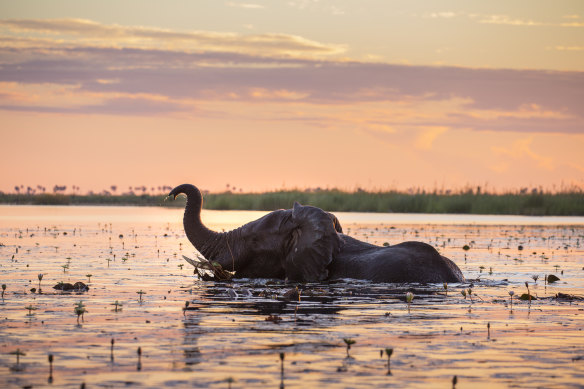
Going with the flow: Zbadanja Lagoon, part of the Linyanti Reserve. The Selinda Spillway connects this waterway with the Okavango Delta.
Botswana is larger than France, but more than 70 per cent of its territory is covered by the Kalahari Desert. Without the annual floodtide to revitalise the Okavango Delta’s sprawling wetlands, the country’s northwest would be incapable of sustaining life, which includes some of the world’s most endangered animals as well as dozens of small villages sprinkled along its banks.
Little wonder then that the Tswana prize water more highly than diamonds, the country’s second-biggest industry and export. The local word for rain, “pula”, is both the name of the national currency and how you say “cheers” when friends clink their glasses.
When the floodwaters finally arrive, usually in April, the gateway city of Maun erupts with jubilant flood parties. Families and friends gather by the banks to fire up their barbecues and raise a toast. Elephants trumpet in ecstasy at the satiating waters. Roads are inundated and potholes become nurseries teeming with goggle-eyed juvenile frogs.
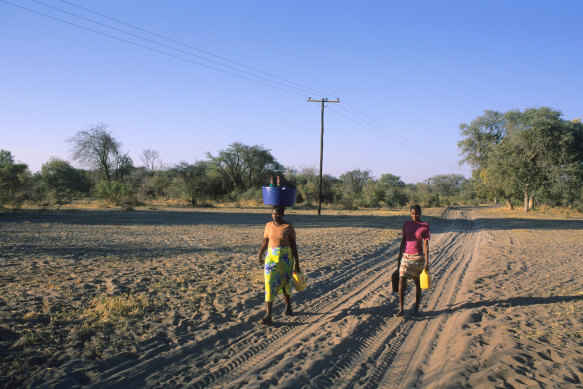
Without the annual floodtide, northern Botswana would be incapable of sustaining life. Credit: Alamy
But this year there has been less rainfall than expected; the deluge is late. I’ve arrived from soggy Melbourne, and my guide jokingly hopes I’ve brought the water with me. With a flourishing tongue-roll he names me “rrapula” meaning “the man that brings rain”. I board a light plane and soon I’m soaring high over the floodplains.
I’m bound for North Island Okavango, a luxuriously modern camp established by conservation-driven safari company Natural Selection in June last year. The island, which forms a mosaic with other islands in a private concession close to the delta panhandle, is accessed only by a single bridge.
Unlike southern parts of the delta, there is water here almost year-round, making it the ideal starting place to follow the floodwaters as they descend into the delta and watch as a new season of renewal unfolds.
As our plane approaches camp, I look down to see hundreds of crisscrossing channels that have been carved through the tall grass by elephant and hippo – architects of this sprawling landscape – like blood vessels and arteries pumping life into Africa’s watery heartland.
Of African massages and dugout canoes
In the last two days we’ve driven past the same stretch of marshlands half a dozen times, but this afternoon something has caught the attention of Tshiamo “Parks” Maphakela, our guide.
“This was not here yesterday,” he says, while pointing to a thin band of water seeping through the tall grass. It’s the first sign we’ve seen that the floodwaters are moving south.
While I’ve been captivated by a patrol of banded mongoose capering like a living carpet in the distance, and stiff-tailed warthog piglets kicking up sooty trails by the road, Parks has been watching for the water the whole time. There’s no time to tarry, though. We have an appointment to keep.
Parks kickstarts the ignition and we’re tumbling off again in the Landcruiser, the bumpy road giving me one of those famous “African massages”.
We round the bend to find a herd of elephant grazing on the trees, unintentionally startling a calf and causing it to turn and run into a bull. He thunders his displeasure. Moving quickly past, we arrive at a channel that has been burnished bronze by the setting sun.
Our speedboat awaits, ready to whisk us off to drinks on the water, but we also find someone unexpected. Beside our boat is Charles Botros, a fisherman from nearby Gunotsoga village. His silver net unspools to the water’s edge, where a pair of hippos furtively watch as Charles packs away his gear for the day.
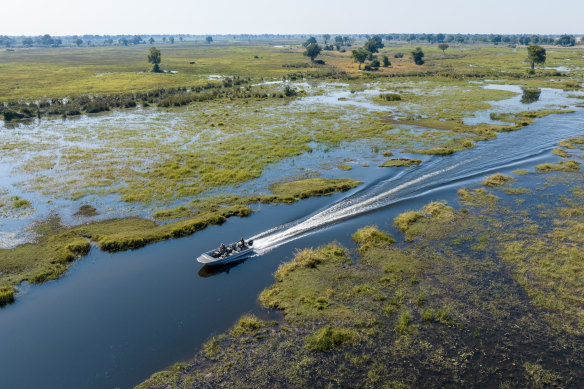
The Okavango Delta sustains a vast web of wildlife, but coexistence is an everyday challenge for the Tswana who live here.
“They hate the mokoro,” he says matter-of-factly, referring to his slender dugout canoe hauled up onto the banks. “They fight it and then eat you.”
The Okavango Delta sustains a vast web of wildlife, but coexistence is an everyday challenge for the Tswana who live here. Elephants raid crops, lions take cattle and hippo attacks on fisherfolk are common. Charles tells me the prolonged dry season means few people at the Gunotsoga market have money to buy the fish he catches, begging the question whether it is worth the risk of stepping into his mokoro. He says he is better off eating his catch rather than trying to sell it.
After climbing into our speedboat and jetting off down the channel, Parks reveals that his own parents were fisherfolk too, and he would join them on their mokoro. But that was only when he was older, as younger children were not permitted to go into the bush.
At eight years old, Parks saw his first elephant after being allowed to walk from his farm into the village. “I thought it was a cloud!” he recalls. “Now, I see elephants everywhere.”
Thankfully, Parks is a much better naturalist today, rattling off keen-eyed sightings and wildlife details as we cruise the waterway. A dazzlingly blue and orange malachite kingfisher rests on the bow of a bent reed, surveying the shallows for silvery fish. Nearby, a grinning crocodile watches us before sliding off the banks and into the water. Baboons quietly gossip in the trees.
A sudden pop cracks the air and a champagne cork ricochets off the boat’s canvas roof, landing among the biltong, pistachio and dried mango arrayed for us to nibble as we sip our sparkling sundowners.
As if on cue, an elderly bull elephant emerges among the rushes. Unfussed by our presence, he diligently washes his food before eating it, rinsing away the grit and gravel that could wear down his teeth. We stay with him for that magical time between sunset and dusk until he’s just a black silhouette in the blushing afterglow.
From snowflake grasses to unfurling water lilies
Charles’ words are echoing in my ears as my mokoro is pushed away from the banks and slides into the water. “Don’t worry. There is no hippo here. They come at night,” says Ola Tlale after reading my face.
Standing behind me, Ola pushes our canoe along a serene waterway using a long wooden pole. Thickets of gleaming snowflake grass drift by as he rhythmically carries us over the clear, lily-padded waters. Even if we did inexplicably capsize, it’s so shallow I could stand without getting my knees wet.
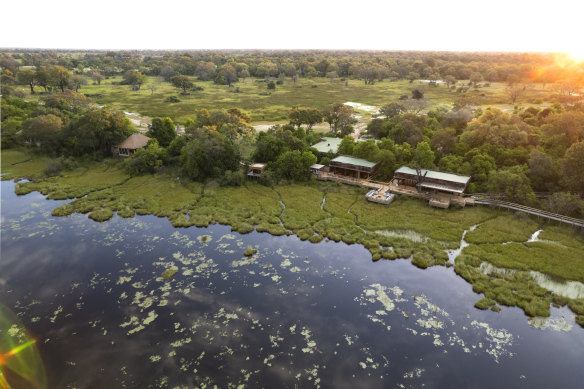
Vumbura Plains camp: Wildlife freely come and go from this lagoon.
I’ve followed the delta 30 kilometres east to Vumbura Plains, another luxury camp this time operated by Wilderness on a private 90,000-hectare concession abutting Moremi Game Reserve. The camp’s elevated lodgings are spectacularly situated at the edge of a lagoon where wildlife freely come and go.
We’re not permitted to walk to our rooms after dark without an escort in case hippo or other animals venture into our path. Just as well, as one evening I’m told a lion pride has set up behind my suite. Not all wildlife is so imposing, I learn, when I find red squirrels cavorting at my front door the following morning.
Like Natural Selection, Wilderness recruits nearly all its camp staff from villages along the Okavango Delta. It’s a conscious effort to spread the benefits of tourism among the locals, creating opportunity and making communities feel invested in protecting their natural heritage.
Whereas Tanzania and Kenya face pressure associated with overtourism, with Kenya’s Masaai Mara National Park receiving scrutiny after a viral video captured a distressed cheetah being cornered by safari vehicles, Botswana has purposely crafted a tourism strategy that favours low-volume tourism with exceptional wildlife viewing.
That’s not to say game drives aren’t still a big part of the experience. The herbal perfume of wild sage greets us as we embark at dawn in search of wildlife, never knowing what drama we’ll find on the road. Sightings, like lions lounging by a rivulet or a python fatally constricting an impala, occur so frequently that I stop listening when I’m repeatedly told how supposedly rare they are.
But recruiting from local communities allows Wilderness to offer slower, more intimate cultural experiences too, like a sunset safari in a mokoro.
Instead of hyenas and lions, I spy mottled Angolan reed frogs in the rushes and sea eagles fishing in the shallows. All I can hear is the melodious tinkling of water punctuated by the sharp calls of red-billed wattle cranes as Ola quietly poles us along.
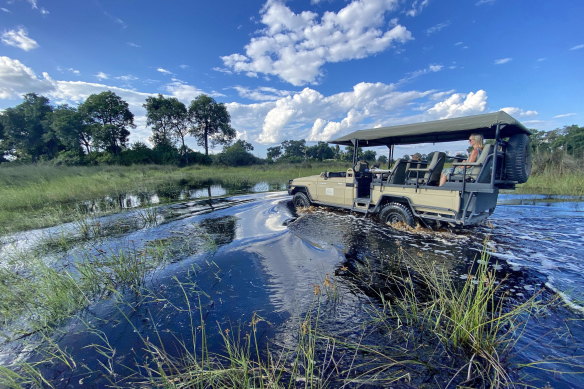
On at game drive with North Island Okavango.
Ola learnt his craft from his grandfather when he was a lad and uses his mokoro to fish, forage and transit between villages. He only takes guests in places where he knows hippo do not frequent. As we move, Ola points out the near imperceptible rhythms of the bush, like the water lily slowly furling its white petals as daylight fades.
The mokoro unexpectedly slows and then stops. I turn to see Ola has plucked a reed out of the water. His deft hands moving quickly, he strips the reed’s stringy exterior and braids the strands to create a band that he ties around my wrist. Later, he fashions another reed into a necklace with a beautifully fibrous hanging pendant.
We land back at our starting point to find glowing lanterns surrounding a waiting pop-up bar. “Yes,” the blazing sky seems to call, “it is time for yet more sundowners.”
Choosing a traditional Amarula, a creamy South African liqueur made from fermented marula fruit that is reminiscent of Irish Baileys, our group toasts the sunset. “Pula!” we cheer, and clink our drinks. Our guide replies: “May it fall.”
Along the ancient elephant corridors
Back in the light plane, I’ve taken a great impala leap 90 kilometres north-east to Linyanti Reserve, near the border of Botswana and Namibia. Home to vast grasslands and mopane woodlands, this reserve also marks the beginning of the long and slender Selinda Spillway.
For now, the spillway is still dry, but floodwaters will soon cause the channel to flow west and connect with the Okavango Delta, opening a migratory passage for elephants to move into the Delta.
Botswana is home to an estimated third of Africa’s elephant population, which have flourished in a country that has dedicated almost 40 per cent of its land to conservation. While elephants can be found nearly everywhere, Wilderness DumaTau’s unique location makes for spectacular pachyderm viewing.
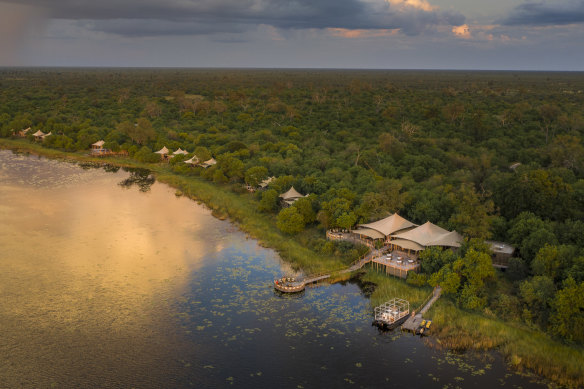
DumaTau: Seated at the edge of the spillway in Zbadanja Lagoon, the camp straddles ancient elephant corridors.
Seated at the edge of the spillway in Zbadanja Lagoon, the camp straddles ancient elephant corridors that have been passed down from elders to calves over generations. Shortly after checking in, I’m spellbound when a bull pops up beside my private pool to graze on lush reeds.
I decide to join him for lunch and head to the jetty to find a barge laden with delicious grain salads, apricot-glazed chicken and lamb kofte, with sweating bottles of rosé and pinot grigio to match.
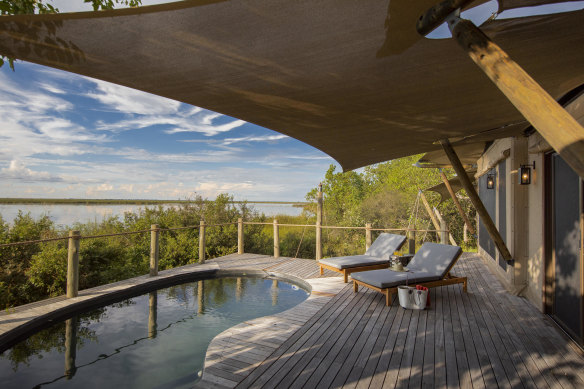
A private pool at DumaTau.
Casting off, we lazily drift through the lagoon, and I’ve barely loaded my plate before we meet a herd of more than 30 elephants assembled along the bank. I’ve forgotten my plate entirely when they begin to swim en masse to the opposite side, the calves using their little trunks to hold on to their parents’ tails as they paddle.
Come nightfall, the elephants have disappeared into the long reeds when I settle into my seat around the firepit. After taking the barge out again at sunset to spot hippo, I’ve returned to camp and descended a long wooden staircase to a boma floating in the lagoon.
Ringed in the soft glow of lamplight, the circular pontoon is a spectacularly inviting piece of architecture designed to lure guests from their rooms and recount the day over a glass of wine.
Flames lick at the air, embers rising to the glittering sky above. Fireflies swirl in the darkness, their glowing bodies reflecting on the still black water like shooting stars.
My thoughts turn to the Okavango Delta itself, watching its first watery tendrils as they started to curl around the dusty archipelago surrounding North Island. It’s still so far away, and an impossibly intricate web of life waits for it. I wonder how many fish filled Charles’ net today, and when the impatient elephants can finally move west to feast and drink in the delta’s rushes.
I pray the delta can make it in time. I hope it can hear me.
HOOFNOTE: The floodwaters did eventually arrive after the writer’s departure with the waters of Okavango Delta returning to their average levels.
The details
Tour
Bench Africa specialises in tailored safari experiences ranging from less than $250 a day to $1000-plus a day. Packages can include return light aircraft transfer, game walks and drives, park fees, laundry, meals, drinks and a selection of activities. See benchafrica.com; naturalselection.travel; wildernessdestinations.com
Fly
Qantas flies direct from Sydney to Johannesburg. Emirates flies from Melbourne, Sydney and Perth to Johannesburg via Dubai. South Africa airlines flies direct from Perth to Johannesburg. Connect from Johannesburg to Maun with one of three regional carriers. See qantas.com, emirates.com; flysaa.com
Five things you need to know
Planning
Botswana’s “dry season”, typically from April to October, is an oxymoron. While there is less rain falling directly on the Okavango Delta, it is far from dry, as this is when seasonal floodwaters reach the delta from Angola. April to October is typically promoted as the ideal months for prime wildlife viewing, but the Okavango Delta has excellent game viewing year-round. Floodwaters recede from November to March, forcing predator and prey into close contact as water becomes scarce, resulting in exciting encounters.
Money
Botswana’s official currency is the Pula, but South African Rand and US dollars are widely accepted. ATMs are unreliable outside major cities. Always carry some cash, preferably South African Rand, for tipping. It is common to tip guides ZAR 70 a day per guest, and camp staff ZAR 47 a day per guest. Tipping is not expected in taxis, and only at high-end restaurants.
Health
A yellow fever vaccination certificate is required if you are over one-year-old and travelling from a country where yellow fever is present, like Tanzania and Kenya. Get vaccinated before you travel. Malaria is present in Botswana, including parts of the Okavango Delta. Pack heavy-duty mosquito repellent and anti-malarial tablets, available from pharmacies with a prescription.
Wear
White, black and blue stand out like a beacon in the bush, alerting all wildlife to your presence. To improve the chance of wildlife sightings, wear green, grey and khaki colours that match the landscape. Game drives take place before sunrise and just before sunset. Wear layers, including long-sleeved tops and pants, so you can adapt to the changing temperatures.
Accessibility
Accessibility is far from uniform across Botswana. It is best to book through a tour operator to ensure transport and accommodation needs are met.
The writer travelled as a guest of Bench Africa.
Sign up for the Traveller Deals newsletter
Get exclusive travel deals delivered straight to your inbox. Sign up now.